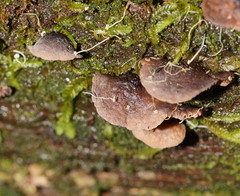Identifying Harpobittacus Scorpion-Flies in Australia
I have recently acquired a copy of "Revision of the Australian Scorpion-fly Genus Harpobittacus (Mecoptera : Bittacidae) Lambkin 1994, with thanks to Kevin J. Lambkin, @christopherburwell and @sdoug7405 and original prompting by @matttudor. Other people who may be interested: @grigorenko @ellurasanctuary @thebeachcomber @rover-rod - if anybody wants a copy I can email it to you (send me a private message if you don't want your email public).
I am working through this now to particularly see the distinction between Harpobittacus australis and Harpobittacus nigriceps and to likely correct many of my past identifications...
The most important section should be the Key, which I have copied out here:
Identification Key to Adults of Harpobittacus
Distal crossvein between CuP and AA3+4 absent in both pairs of wings (Fig. 2) ..... 2
Distal crossvein between CuP and AA3+4 present in at least 1 wing (Fig. 1) ..... 4Face orange medially (as in Fig. 6) ..... H. scheibeli
Face entirely black ..... 3Abdominal tergites black; mainland south-eastern Australia ..... H. nigriceps
Abdominal tergites 2-5 orange; Western Australia ..... H. phaeosciusMesonotum almost entirely black except for small areas posteromedially and posterolaterally; at least anterior } of metanotum black (Fig. 9); o* head with a deep cavity below antennae (Fig. 5) Western: Australia ..... 5
Mesonotum black over anterior 1/2 only; metanotum entirely orange or with a pair of black spots anterolaterally (Fig. 10); female head with at most a shallow depression below antennae; eastern and south-eastern Australia ..... 6Propleuron black; epiandrial lobe almost parallel-sided in lateral view, densely setose dorsally (Fig. 35) and with medial lobe elongate (Fig. 24); anterior setose areas of GS8 with a combined total of >6 long, thick setae (Fig. 65) ..... H. similis
Propleuron orange; epiandrial lobe dilated apically in lateral view, sparsely setose dorsally (Fig. 36) and with medial lobe short (Fig. 25); anterior setose areas of GS8 with a combined total of <6 long, thick setae (Fig. 66) ..... H. quasisimilisHind margin of pronotum narrowly orange (Fig. 13); epiandrial lobes flexed longitudinally
(Figs 26, 27), in lateral view broad (c. 2× as long as wide) (Figs 37, 38); basistylus black; female S7 wider than long, strongly tapered anteriorly (Fig. 57); GS8 with an anterior hook-like extension (Fig. 67) ..... 7
Hind margin of pronotum black; epiandrial lobes not flexed longitudinally, in lateral view elongate (mostly >2x as long as wide) (Figs 30-34); basistylus orange; female S7 longer than wide, not strongly tapered anteriorly (Figs 50-54); GS8 without an anterior hook-like extension Figs 60-64) ..... 8Propleuron entirely orange; hind margin of black area on mesonotum inverted V or U-shaped (Fig. 7); epiandrium in lateral view narrower basally than at midlength (Fig. 37), in dorsal view with medial region short (Fig. 26); central Queensland to New South Wales ..... H. scheibeli
Propleuron usually with a dorsal black spot (Fig. 13); hind margin of black area on mesonotum usually nearly straight (Fig. 8); epiandrium in lateral view as broad basally as at midlength (Fig. 38), in dorsal view with medial region long (Fig. 27); north Queensland ..... H. septentrionisMales ..... 9
Females ..... 13Metanotum black anterolaterally (Fig. 10); epiandrial lobe with dorsal margin nearly straight in lateral view, apex not upcurved (Fig. 34) ..... H. rubricatus
Metanotum entirely orange; epiandrial lobe with dorsal margin concave subapically or sinuous in lateral view, apex at least slightly upcurved (Figs 30-33) ..... 10Epiandrial lobe short, in lateral view c. 2x as long as wide, apex only slightly upcurved (Fig. 33) ..... H. tillyardi
Epiandrial lobe elongate, in lateral view >2%x as long as wide, apex strongly upcurved (Figs 30-32) ..... 11Pronotum entirely black; inner ridge of epiandrial lobe strongly produced mesad as a tooth-like lobe (Fig. 19) ..... i. australis
Pronotum usually with some orange laterally, at least in a small spot at base of lateral seta (Figs 11, 12); inner ridge of epiandrial lobe only slightly produced mesad (Figs 20, 21) ..... 12Epiandrial lobe in lateral view <3 x as long as wide and tapered apically (Fig. 31) ..... *H. albatus*
Epiandrial lobe in lateral view more elongate, >3x as long as wide and not tapered apically ..... M. christineGS8 with 2 areas of long, thick setae (Figs 61, 72) ..... Y. albatus
GS8 with 1 (posterior) area of long, thick setae (Figs 60, 62-64) ..... 14S7 entirely black, or black with a longitudinal orange stripe (Fig. 16) ..... 15
S7 entirely orange, or at most with lateral margins narrowly black (Fig. 17) ..... 16Lateral regions of pronotum orange (Fig. 12); metanotum entirely orange; GS8 broad and plate-like, not noticeably tapered anteriorly (Fig. 62) ..... H. christine
Pronotum entirely black; metanotum black anterolaterally (Fig. 10); GS8 narrow, tapered to an acute angle anteriorly (Fig. 64) ..... H. rubricatusT5 entirely orange, or sometimes suffused with black anteriorly and posteriorly; GS8 narrow, tapered to an acute angle anteriorly (Fig. 63) ..... H. tillyardi
T5 entirely black, or sometimes with an orange area posteromedially; GS8 broad and plate-like, not noticeably tapered anteriorly (Fig. 60) ..... H. australis
From distribution maps
- H. australis distributed through much of Victoria (excluding northern & north-western inland), Tasmania and along the coast of South Australia to the Eyre Peninsula and through the mountainous regions of NSW to the Qld border
- H. christine Bunya/Towoomba regions
- H. albatus costal regions from Wollongong to Rockhampton (plus a couple of records a bit more inland and one in Townsville)
- H. septentrionis Mackay to Cairns
- H. scheibeli southern Qld quite far inland and just into northern NSW
- H. nigriceps SE corner of SA along coast then broadening range through central Victoria into west Gippsland from Wilsons Prom and along northern foothills just into NSW.
- H. tillyardi coastal NSW and coastal southern Qld
- H. rubricatus southern inland Qld, inland NSW into NW Vic and through middle third of SA to top of Eyre Pen.














 Several years ago I was considering writing a book on Victoria's dragonflies and damselflies, having seen and photographed nearly every species in the state. As I started collating some photos I realized many were not of publishable quality. For example, in latter years I wasn't bothering trying to photograph the very common
Several years ago I was considering writing a book on Victoria's dragonflies and damselflies, having seen and photographed nearly every species in the state. As I started collating some photos I realized many were not of publishable quality. For example, in latter years I wasn't bothering trying to photograph the very common 

